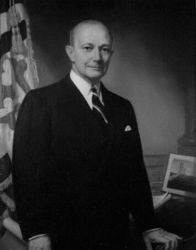|
|

Photo From: Jack Barnes - Album: No Album
Description: 52nd Governor of Maryland for whom the Chesapeake Bay Bridge is named. Uploaded: 3/1/2007 by Jack Barnes
See what is being said about this image in the messages area.
Comments on this Image: You must be registered user and logged in to comment.
Login or Register and you will be returned to this image page.
Comments on this Image: You must be registered user and logged in to comment.
Login or Register and you will be returned to this image page.
|
(8/6/2015) Joe Reynolds wrote:
William Preston Lane, Jr. In 1946, Lane decided to run for governor. In the Democratic primary election, he defeated challengers J. Millard Tawes and H. Streett Baldwin, and then defeated Republican Theodore R. McKeldin in the general election 54% to 45%.[1] As governor, Lane and his administration worked towards improving the public education, mental health, and highway systems of the state. A newspaper report published in 1949 exposed serious flaws in the treatment of the mentally ill in the state, which resulted in the creation of the Department of Mental Hygiene and turned Maryland's mental hospitals by the end of the Lane administration into some of the best in the nation. Major highway improvements which had been deferred by World War II were also put in motion by Lane, which were funded by an increase in the state sales tax. The Chesapeake Bay Bridge, which now carries his name, was completed in 1952 under this plan. Several historic state facilities were also renovated during Lane's tenure, including the Maryland State House which had not been adequately preserved since its construction in 1772. Lane faced George P. Mahoney, a perennial candidate, in the 1950 Democratic primary election held on September 18, 1950.[1] The primary was close and bruising, and left the Lane campaign weakened for the general election against Theodore McKeldin, his opponent in the 1946 election. Additionally, his unpopular sales tax to fund road improvements had caused significant dissent in the state and was used by McKeldin to pull votes away from Lane. On November 7, 1950, Lane was defeated in the general election by 94,000 votes, 57% to 42%. At that point, it was the largest margin of defeat in Maryland history. Lane's term as governor ended on January 10, 1951. |



